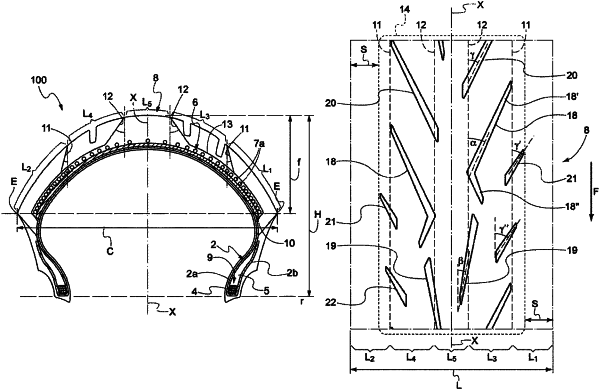| CPC B60C 11/033 (2013.01) [B60C 11/0058 (2013.01); B60C 11/0302 (2013.01); B60C 2011/0025 (2013.01); B60C 2200/10 (2013.01)] | 22 Claims |

|
1. A motorcycle tyre comprising an equatorial plane (X-X) and a tread band having an axial development, wherein:
the tread band comprises at least one first annular portion made of a first elastomeric material having a first dynamic shear storage modulus measured at 70° C., at least one second annular portion made of a second elastomeric material having a second dynamic shear storage modulus measured at 70° C. different from the first dynamic shear storage modulus, and at least one third annular portion located across the equatorial plane (X-X);
the at least one first annular portion is located in a tread band region at a distance from the equatorial plane (X-X) equal to at least 25% of the axial development;
the at least one second annular portion is adjacent and axially proximal to the at least one first annular portion and defines a first interface dividing the at least one first annular portion from the at least one second annular portion in the axial direction;
the tread band further comprises a plurality of grooves and a void-to-rubber ratio at the first interface which increases along the axial development from the at least one first annular portion to the at least one second annular portion;
the void-to-rubber ratio increases from a minimum value associated with an annular sector of the at least one first annular portion to a maximum value associated with an annular sector of the at least one second annular portion,
the void-to-rubber ratio at the first interface is greater than or equal to 3% and less than or equal to 15%,
the third annular portion has an overall void-to-rubber ratio equal to or less than 3%,
the first interface is angled towards the equatorial plane from inside of the tread band to outside of the tread band, and the first interface relative to the equatorial plane (X-X) is angled between 10° and 20°; and
a second interface dividing the at least one third annular portion from the at least one second annular portion is angled towards the equatorial plane from inside of the tread band to outside of the tread band, and the second interface relative to the equatorial plane (X-X) is angled between 30° and 40°.
|